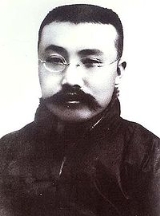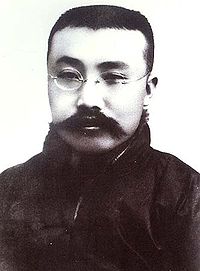
Li Dazhao
Encyclopedia
 |
|
| Li Dazhao | |
|---|---|
| Traditional Chinese: | 李大釗 |
| Simplified Chinese: | 李大钊 |
| Pinyin Pinyin Pinyin is the official system to transcribe Chinese characters into the Roman alphabet in China, Malaysia, Singapore and Taiwan. It is also often used to teach Mandarin Chinese and spell Chinese names in foreign publications and used as an input method to enter Chinese characters into... : |
Lǐ Dàzhāo |
| Wade-Giles Wade-Giles Wade–Giles , sometimes abbreviated Wade, is a romanization system for the Mandarin Chinese language. It developed from a system produced by Thomas Wade during the mid-19th century , and was given completed form with Herbert Giles' Chinese–English dictionary of 1892.Wade–Giles was the most... : |
Li Ta-Chao |
Li Dazhao (October 29, 1888 - April 28, 1927) was a Chinese
China
Chinese civilization may refer to:* China for more general discussion of the country.* Chinese culture* Greater China, the transnational community of ethnic Chinese.* History of China* Sinosphere, the area historically affected by Chinese culture...
intellectual who co-founded the Communist Party of China
Communist Party of China
The Communist Party of China , also known as the Chinese Communist Party , is the founding and ruling political party of the People's Republic of China...
with Chen Duxiu
Chen Duxiu
Chen Duxiu played many different roles in Chinese history. He was a leading figure in the anti-imperial Xinhai Revolution and the May Fourth Movement for Science and Democracy. Along with Li Dazhao, Chen was a co-founder of the Chinese Communist Party in 1921. He was its first General Secretary....
in 1921.
Early life
Li was born in Laoting (a county of TangshanTangshan
"唐山"redirects here. For an alternative name of China, see Names of China#TangTangshan is a largely industrial prefecture-level city in Hebei province, People's Republic of China. It has become known for the 1976 Tangshan earthquake which measured 7.8 on the Richter scale and killed at least...
), Hebei
Hebei
' is a province of the People's Republic of China in the North China region. Its one-character abbreviation is "" , named after Ji Province, a Han Dynasty province that included what is now southern Hebei...
province to a peasant family. He began his high school education at Tangshan Number 1 High School in 1905. From 1913 to 1917 Li studied political economy at Waseda University
Waseda University
, abbreviated as , is one of the most prestigious private universities in Japan and Asia. Its main campuses are located in the northern part of Shinjuku, Tokyo. Founded in 1882 as Tokyo Senmon Gakko, the institution was renamed "Waseda University" in 1902. It is known for its liberal climate...
in Japan
Japan
Japan is an island nation in East Asia. Located in the Pacific Ocean, it lies to the east of the Sea of Japan, China, North Korea, South Korea and Russia, stretching from the Sea of Okhotsk in the north to the East China Sea and Taiwan in the south...
before returning to China in 1918.
Librarian at Peking University
As a leading intellectual in the New Culture MovementNew Culture Movement
The New Culture Movement of the mid 1910s and 1920s sprang from the disillusionment with traditional Chinese culture following the failure of the Chinese Republic, founded in 1912 to address China’s problems. Scholars like Chen Duxiu, Cai Yuanpei, Li Dazhao, Lu Xun, Zhou Zuoren, and Hu Shi, had...
, Li was recruited by Cai Yuanpei
Cai Yuanpei
Cai Yuanpei was a Chinese educator and the president of Peking University. He was known for his critical evaluation of the Chinese culture that led to the influential May Fourth Movement...
to head the library at Peking University
Peking University
Peking University , colloquially known in Chinese as Beida , is a major research university located in Beijing, China, and a member of the C9 League. It is the first established modern national university of China. It was founded as Imperial University of Peking in 1898 as a replacement of the...
. In this position he influenced a number of students in the May Fourth Movement
May Fourth Movement
The May Fourth Movement was an anti-imperialist, cultural, and political movement growing out of student demonstrations in Beijing on May 4, 1919, protesting the Chinese government's weak response to the Treaty of Versailles, especially the Shandong Problem...
, including Mao Zedong
Mao Zedong
Mao Zedong, also transliterated as Mao Tse-tung , and commonly referred to as Chairman Mao , was a Chinese Communist revolutionary, guerrilla warfare strategist, Marxist political philosopher, and leader of the Chinese Revolution...
, who worked in the library's reading room. Li was among the first of the Chinese intellectuals to look to China's villages as a basis for a political movement and was among the earliest to explore the Bolshevik
Bolshevik
The Bolsheviks, originally also Bolshevists , derived from bol'shinstvo, "majority") were a faction of the Marxist Russian Social Democratic Labour Party which split apart from the Menshevik faction at the Second Party Congress in 1903....
government in the Soviet Union
Soviet Union
The Soviet Union , officially the Union of Soviet Socialist Republics , was a constitutionally socialist state that existed in Eurasia between 1922 and 1991....
as a possible model for China's reform. Even as late as 1921, however, he still maintained warm relations with other New Culture figures such as Hu Shi.
Co-founder of the CPC
By many accounts, Li was a nationalistChinese nationalism
Chinese nationalism , sometimes synonymous with Chinese patriotism refers to cultural, historiographical, and political theories, movements and beliefs that assert the idea of a cohesive, unified Chinese people and culture in a unified country known as China...
and believed that the peasantry in China were to play an important role in China's revolution. As with many intellectuals of his time, the roots of Li's revolutionary thinking were actually mostly in Kropotkin
Kropotkin
Peter Kropotkin was a Russian prince and anarchist.Kropotkin may also refer to:*Pyotr Nikolayevich Kropotkin , Soviet/Russian geologist, tectonician, and geophysicist*Mount Kropotkin, a peak in Antarctica...
's communist anarchism, but after the events of the May Fourth Movement
May Fourth Movement
The May Fourth Movement was an anti-imperialist, cultural, and political movement growing out of student demonstrations in Beijing on May 4, 1919, protesting the Chinese government's weak response to the Treaty of Versailles, especially the Shandong Problem...
and the failures of the anarchistic experiments of many intellectuals, like his compatriots, he turned more towards Marxism
Marxism
Marxism is an economic and sociopolitical worldview and method of socioeconomic inquiry that centers upon a materialist interpretation of history, a dialectical view of social change, and an analysis and critique of the development of capitalism. Marxism was pioneered in the early to mid 19th...
. Of course, the success of the Bolshevik Revolution was a major factor in the changing of his views. In later years, Li combined both his original nationalist and newly acquired Marxist views in order to contribute a strong political view to China (Meisner 1967, 178).
Li initiated the Peking Socialist Youth Corps in 1920 (Pringsheim 1962, p76), in advance of the first meeting of the Communist Party of China
Communist Party of China
The Communist Party of China , also known as the Chinese Communist Party , is the founding and ruling political party of the People's Republic of China...
(CPC) in Shanghai in July, 1921. Though Li was unable to attend, he was named co-founder of the CPC, along with Chen Duxiu
Chen Duxiu
Chen Duxiu played many different roles in Chinese history. He was a leading figure in the anti-imperial Xinhai Revolution and the May Fourth Movement for Science and Democracy. Along with Li Dazhao, Chen was a co-founder of the Chinese Communist Party in 1921. He was its first General Secretary....
.
Under the leadership of Li and Chen, the CPC developed a close relationship with the Soviet controlled Comintern
Comintern
The Communist International, abbreviated as Comintern, also known as the Third International, was an international communist organization initiated in Moscow during March 1919...
. At the direction of the Comintern, Li and Chen were inducted into the Kuomintang
Kuomintang
The Kuomintang of China , sometimes romanized as Guomindang via the Pinyin transcription system or GMD for short, and translated as the Chinese Nationalist Party is a founding and ruling political party of the Republic of China . Its guiding ideology is the Three Principles of the People, espoused...
in 1922. Li was elected to the KMT's Central Executive Committee in 1924.
Death
Tensions between the Comintern, the KMT, and the CPC presented opportunities for political intrigue and opportunism. With the collapse of the United FrontUnited front
The united front is a form of struggle that may be pursued by revolutionaries. The basic theory of the united front tactic was first developed by the Comintern, an international communist organisation created by revolutionaries in the wake of the 1917 Bolshevik Revolution.According to the theses of...
in 1927, Li was captured during a Fengtian ordered raid on the Soviet embassy in Peking (Beijing
Beijing
Beijing , also known as Peking , is the capital of the People's Republic of China and one of the most populous cities in the world, with a population of 19,612,368 as of 2010. The city is the country's political, cultural, and educational center, and home to the headquarters for most of China's...
). Along with nineteen others arrested in the raid, he was executed on the orders of the warlord Zhang Zuolin
Zhang Zuolin
Zhang Zuolin was the warlord of Manchuria from 1916 to 1928 . He successfully invaded China proper in October 1924 in the Second Zhili-Fengtian War. He gained control of Peking, including China's internationally recognized government, in April 1926...
on April 28, 1927.

